Sunningdale Golf Club (Old Course)
Ascot, Berkshire, United Kingdom
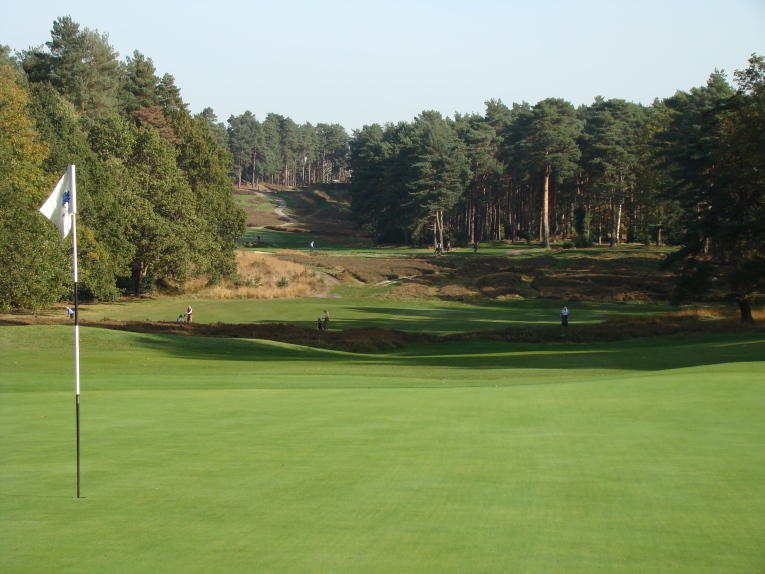
Looking back from the seventh tee. Frank Pennick captured Sunningdale’s essence when he wrote in Homes of Sport – Golf, ‘Never had I seen anything which identified itself so strikingly with my personal picture of a golf course than the views from the fifth and tenth tees, or looking back from that of the seventh.’
Sunningdale breeds loyalty. Since 1901 there have been few but very distinguished club secretaries that include Harry Colt, Major Guy Bennett, and today’s Stephen Toon who has served since 2004. For 56 years James Sheridan was caddiemaster. Arthur Lees was the golf professional for 28 years. Hugh MacLean acted as the construction foreman for the Old Course in 1899 – and stayed until 1939. One of his workers remained gainfully employed for over 60 years! Sunningdale’s club historian John Churchill joined over a half century ago.
Such devotion usually indicates something special and Sunningdale certainly is that. A visit today reveals a club bustling with happy members and their fortunate dogs. A gracious air pervades the place that is the envy of the golfing world. For 115 years its famed oak tree has loomed over golfers heading out and acted as a beacon for their return.
Was this destiny? No, Sunningdale is the exemplar it has become due to uncommonly good sense. The Club might have headed down the wrong path any number of times but didn’t. It could have chosen someone less talented than Willie Park Jr. to build the original course – but didn’t. It could have failed to grasp – but didn’t – the ramifications of the Haskell ball. It could have ignored the Club Secretary’s relentless calls for improvements – but didn’t. The second course might have compromised the first – but didn’t.
Yes, much changed on the Old Course from its opening in 1899 until the magical year of 1926 but the course that we enjoy today is basically what Bobby Jones confronted when he carded that perfect 66 composed of only 3s and 4s. Bernard Darwin called it ‘incredible and indecent.’ On account of indifferent putting, O.B. Keeler noted that Jones ‘… had no luck at all, and needed none.’ Part of that round’s marvel was how many greens Jones hit from 180 to 225 yards away, as many as ten. He never missed even with hickories! Jones (with Keeler) reminisced in Down the Fairway, ‘In my 36 holes there, in the qualifying rounds, I used a mashie twice and a mashie niblick once, for approach shots. The others were good bangs with the irons, or a spoon, or occasionally a brassie. It’s that kind of course.’ Members to this day relate with Jones’s sentiments. Unless the golfer gets away a huge wallop, drives die into up-slopes and a host of greens (e.g. the fourth, sixth, seventh, twelfth, sixteenth, and eighteenth) sit well above a player in the fairway.
Jones was on his game that week and the Old Course made an indelible impression. His feat – and his words of praise – gave the Old Course star power unmatched among the heathland courses, then and now. What was the genesis for this design that so impressed? In a rarity, two of golf ‘s titans had their hands in the pudding.
Sunningdale was at the forefront of bringing meaningful golf inland where it could play a vital role in one’s weekly life. Links golf defined the character of the game in 1899 when Willie Park Jr. began routing the course for the brothers Roberts. Park was surely impressed with Sunningdale’s convoluted land movement, which simulated some of the conundrums posed by links land. The Scot Park did his part by concocting drives over the crests of hills, placing bunkers in the middle of fairways, tilting greens away, and building some massive putting surfaces (the tenth alone was nearly 15,000 square feet).
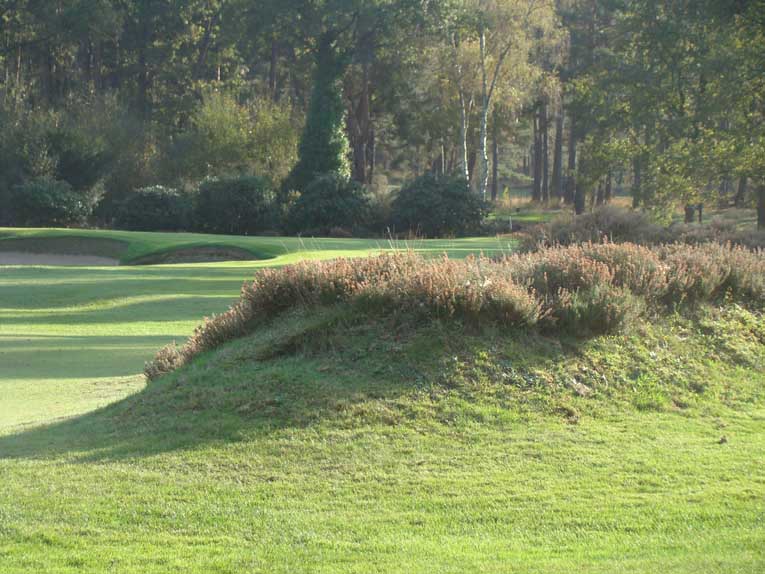
There is golf history and then there is the history of civilization. England plays a lead role in both. Churchill explains that the mounds along the first ‘… in old maps are referred to as “tumuli”, Latin for tombs. During the construction of the Old course a collection of Anglo Saxon urns were uncovered full of skeletal remains, and these are in a museum in nearby Reading. I saw a photo somewhere of these urns being dug up, and the burial place seemed to be very similar in appearance to the tumuli.’
Park’s course was beastly long and required getting down in two putts from well away. In a tip of the hat to The Old Course at St. Andrews, the first and seventeenth holes shared a green. Guy Bennett noted in The Sunningdale Story, ‘Willie Park had the reputation of being a very good putter, and practically all his greens were large, much more so than they are at present. Their size was considerably curtailed, chiefly for economic purposes during the war, which one thinks, makes for an improvement.’
The gutta percha ball was in use when Park built the course but the Haskell emerged a scant two years later. The game and what constituted good golf was changing, and doing so rapidly. At one time blind one shotters were popular, seen from Deal and Sandwich to Aberdovey and here at Park’s first three one shot holes which featured greens located in a bowl (the fourth), behind a fold (the eighth) and a beyond a hill (the thirteenth). As the new century dawned, such holes lost their standing. Bernard Darwin was savagely critical of Park’s one shotters. While Park’s one shotters were mostly rooted in the 19th century, the course was otherwise long and stylish. Might Park have done things differently if he had designed Sunningdale with the Haskell in mind? That’s a difficult question and the ability to answer it in absolutes has been lost with time. However, it is worth noting that the Park family business was golf equipment and perhaps they had a inkling of what would soon emerge. Such knowledge would account for Park’s muscular routing, which clearly made allowances for the anticipated improvements in equipment.
By pure coincidence, the same year that the Haskell appeared, so too did Harry Colt. Sunningdale had sent out requests for a Club Secretary and Colt was among the more than 400 applicants. He assumed the post in 1901. At first he was largely an administrator and player but his services as a golf architect grew during the first decade of the twentieth century. His early gems include Le Touquet, Swinley Forest and St. George’s Hill and by 1913 he had made his mark in North America at mighty Pine Valley and the charming Toronto Golf Club. Still, Park was ‘the man’ at the start of the century and Colt prudently inched his way along in the early years. As his talent blossomed, Colt’s voice became louder and it was soon revealed that his eye for architecture was peerless.
Sheridan sums up Colt the man in Sheridan of Sunningdale:
Mr. H.S. Colt, the secretary, was no easy man to serve. I was astounded at first by the way he seemed to frighten most of the staff and thought this wouldn’t do for me. We had a terrible row when one of the caddies had trouble with a member. “I don’t care what happened, Sheridan,’ he said as I tried to explain. ‘The member is always right.’ ‘Wrong is no man’s right,’ I replied which scarcely poured oil on the troubled waters. I very soon realised what a great and wonderful man he was and, as the years passed, we both achieved a fine regard for each other. Certainly, the secretary had a fierce kick in him, but I prefer men like that. The others desert you when the wind blows.
Bernard Darwin, the dean of golf writing and Colt’s friend, was not charitable in describing Park’s par 3s. Churchill suggests that Darwin’s phrase ‘scathingly dismissed’ may well have reflected upon his friendship with Colt more than the merits of Park’s one shotters. In any event Colt’s initial work concentrated on the first three par 3s. He later eradicated a blind approach shot at the seventh and moved the twelfth green to its current, splendid perch. As things stand, twelve of today’s greens on the Old Course are where Park put them but Colt always, repeat always, gave Park his due. Without doubt, Park deserves credit for the wonderful bones that are the Old Course.
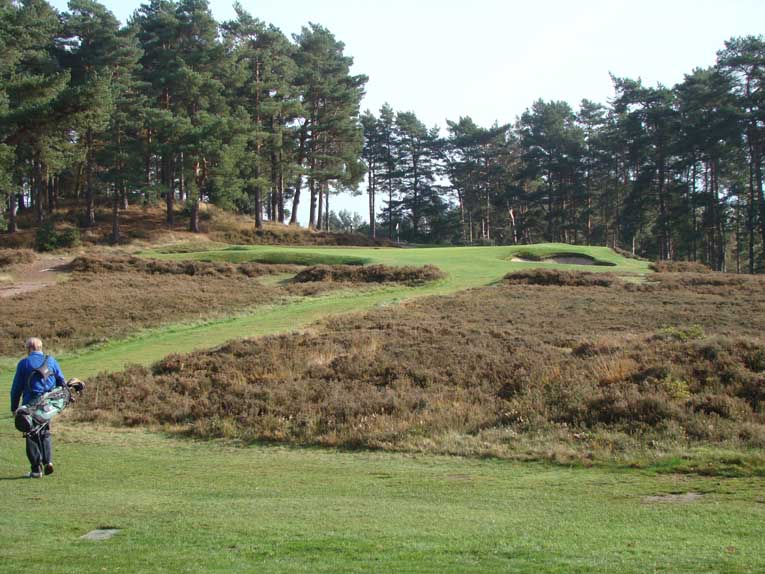
Park’s original fourth played over Mr. Churchill’s headcover to a green located in a bowl short and left of today’s location.
Colt remained the Club Secretary until 1913 when his travel schedule forced the Club to reluctantly accept his resignation (he had tried prior in 1911). However, his work on the Old was not finished and when the Club hired him to build the New Course in 1922, Colt made alterations to the first, seventeenth and eighteenth to make room for its sibling. Of note, the original first tee was once virtually beneath the great oak.

Play once commenced from near the most famous tree in golf. Colt’s movement of the Home green to make room for the New lead to today’s tee.
Fortunately for the Club, two of the greatest figures in British golf architecture shepherded the course through its infancy. Coincidently or not, both were crack players. Sheridan spoke about Colt: ‘I had been in Hoylake in 1906 when he was one of three Sunningdale men in the semi-final of the Amateur Championship. Yet, none of them won!’ Willie Park Jr.’s playing record includes two Open titles and needs no elaboration. Sunningdale’s enticing shot values and her enduring golf qualities stem from these gentlemen’s innate understanding of the game.
Holes to Note
Second hole, 490/455 yards; Beginning 5-5 is not ideal but demonstrates in techno-color that Willie Park was a lay-of-the-land architect. Two long holes was the best start for the property and one must presume that Park was trying to ‘connect the dots’ to reach the magical fifth tee. Technology renders this hole a long two shotter but its not length that makes it difficult or noteworthy. Its intrinsic playing characteristics are derived from the natural slope of the land (including the green) that falls away from the player. It’s a long hole where a short approach is more problematic than a strong one. Golf has been played at Sunningdale in three (!) different centuries and it is most satisfying that the ground game is still very much apart of the proceedings.
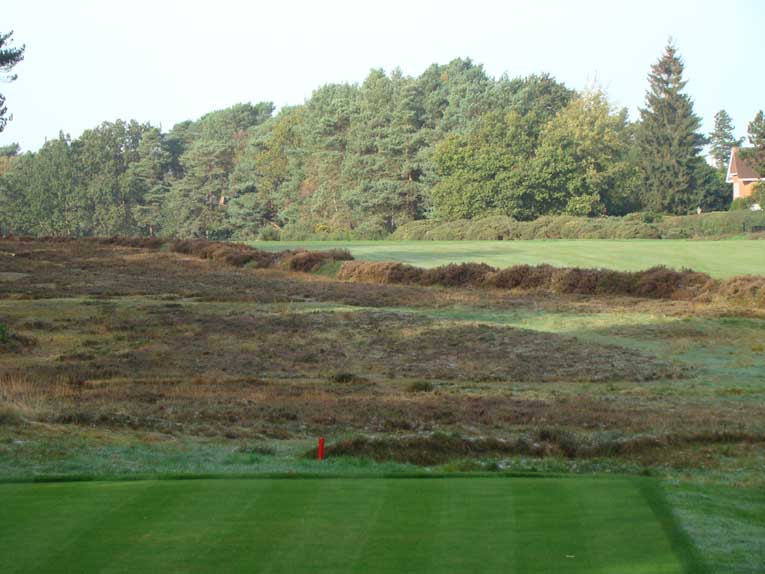
Today’s tee location creates an appealing diagonal carry. Park draped the second fairway up and over the rise where it falls away through the putting surface.
Third hole, 320/290 yards; Comparing the merits of the Old and New Courses is a debate without end. One thing is for sure: if you are a connoisseur of the short par 4, then your allegiance lies with the Old. This and the eleventh hole have significantly influenced golf architecture. Tom Doak captures the essence of the hole well with his diagram in Anatomy of a Golf Course. Seemingly short and simple, the action commences with the need to clear two bunkers on the far side of a shallow valley. Do that and you realize the optimum playing angle to this left to right canted green. The tension created by the seven bunkers down the right combined with the green’s slope is outstanding.
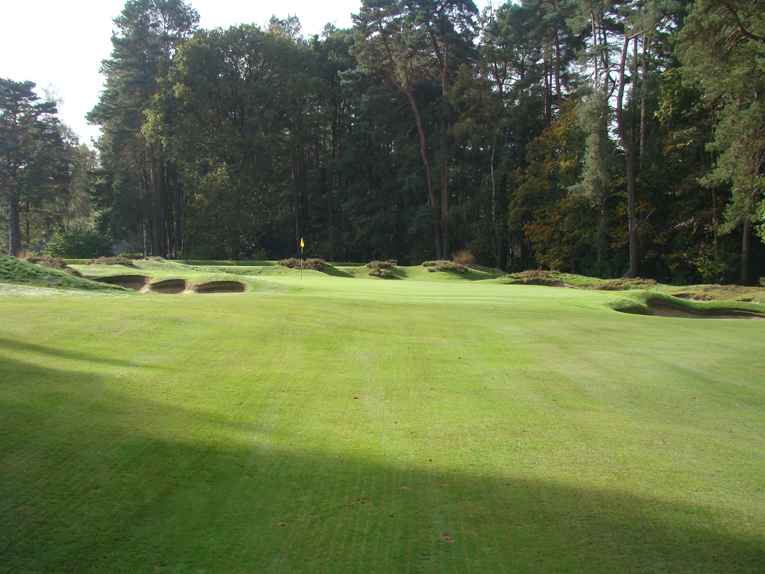
The telltale left to right pitch of the green is evident. It’s second only to the eleventh as the smallest green on the course.
Fifth hole, 420/400 yards; This timeless beauty is probably the most oft-painted heathland hole. As with the tenth, the green is large, 35 paces in depth. Everything is in scale with nothing jarring or out of place; the eye happily wanders down the length of the hole, soaking it all in. When play first commenced, golf balls were expensive and one imagines the anxiety created by the pond on one’s approach! There can be as much as a three clubs difference between front and back hole locations. With no framing around the green to assist with depth perception, getting one’s shot hole high is more difficult than one suspects. Cecil Aldin eternalized the fifth with his 1920 effort that spectacularly captured Sunningdale’s huge expanse of heathland.
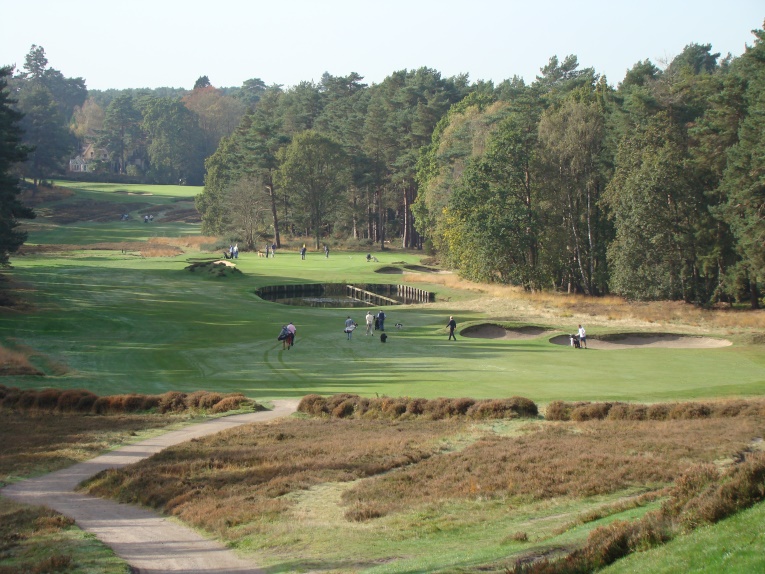
The commanding vista from the fifth tee shows how the green is best approached from the right center of the fairway.
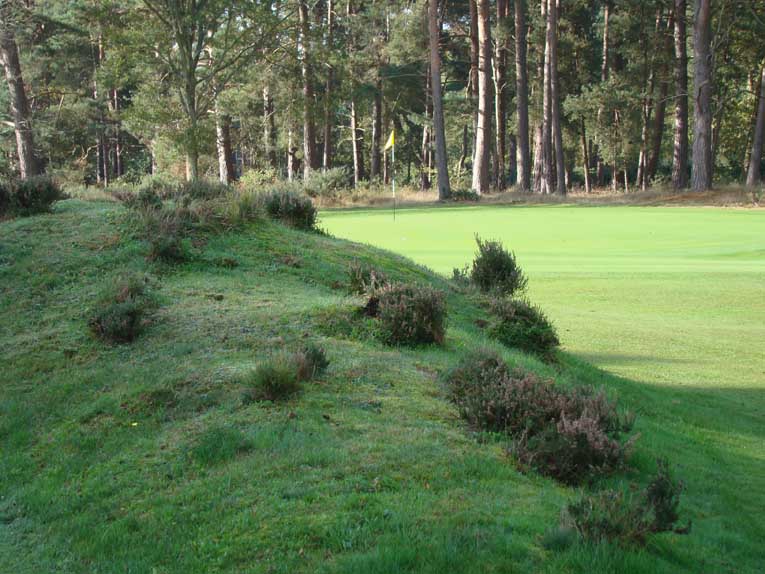
This front left mound provides incentive for staying right off the tee. Note the absence of framing and that the green is at grade with its surrounds.
Sixth hole, 435/385 yards; Darwin conjectured in Golf Courses of the British Isles, ‘I cannot help thinking that the coming of the ‘Haskell’ was a blessing for the course, and that it may be said of Sunningdale, as it can be said for perhaps no other course in Christendom, that it was improved by the rubber-cored ball.’ One wonders exactly what he meant. To the author, he was suggesting that Sunningdale became more enjoyable and playable for a wider audience. Park’s two shotters were defiant as this hole attests. It surely would have been a driver and two wood with a gutty but more members could carry the second swath of heather with the Haskell. One of the hallmarks of good design is the ability to test the best while still offering enjoyable golf for players of any age or ability. Sunningdale masters that balancing act as well as any inland course.
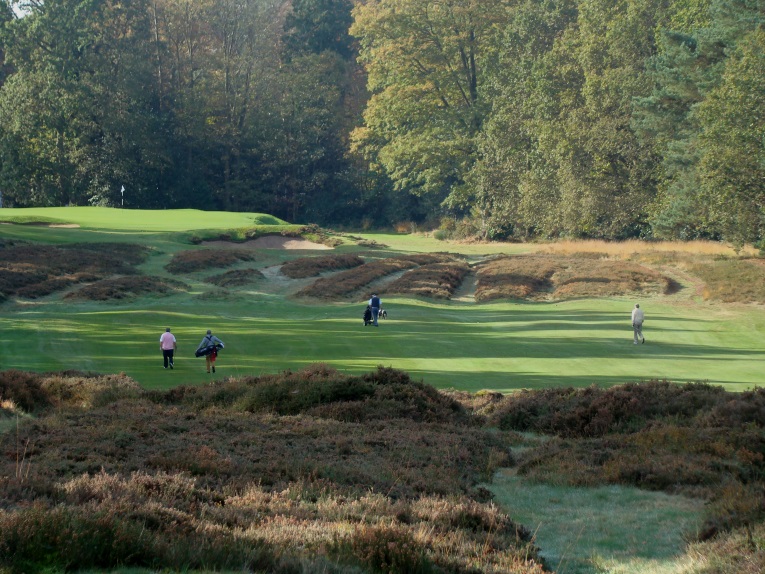
Two forced – though gorgeous – carries at the sixth are eminently easier with the modern rubber-cored ball. Churchill notes that the ridges and furrows seen above are a sign of agricultural activity during the medieval period.
Seventh hole, 405/395 yards; Seventh hole, 405/395 yards; The topography that spills away from the famous Edwardian clubhouse is one of the marvels of the golfing world with the stretch from 5 to 10 on the Old as good as it gets. One benefit of such rambunctious land is the ever-changing perspective. Long views were afforded down five and six but at the tee here, the golfer’s view is stunted by an abrupt embankment. After cresting the hill, a glorious scene unfolds as this roly-poly hole twists right to left then left to right near Colt’s green. Similarly, a muted view at eleven follows the big one from the tenth tee. The superior golfing landscape exhilarates the player, leaving him never quite sure what to expect next.

Three of the deepest greenside bunkers define the challenge. Hole locations on the top back plateau are among the hardest on the course.
Eighth hole, 195/170 yards; When Colt moved a Park green, it was generally to higher ground (e.g. the fourth, seventh, here, and twelfth). Agronomic benefits ensued but so did the requirements for higher, more precisely struck shots. Loathe to stereotype, nonetheless it seems fair to say that Colt’s greens repelled while Park’s tended to gather. Today’s eighth with its steep fall-off right is formidable. Modern sand wedges make misses more manageable than recovery shots attempted with a niblick (a.k.a. nine iron) splayed open during Colt’s time. Darwin, never one to mince words, said of his friend’s end product, ‘The eighth is quite a good short hole now (it used to be bad and blind and stupid).’
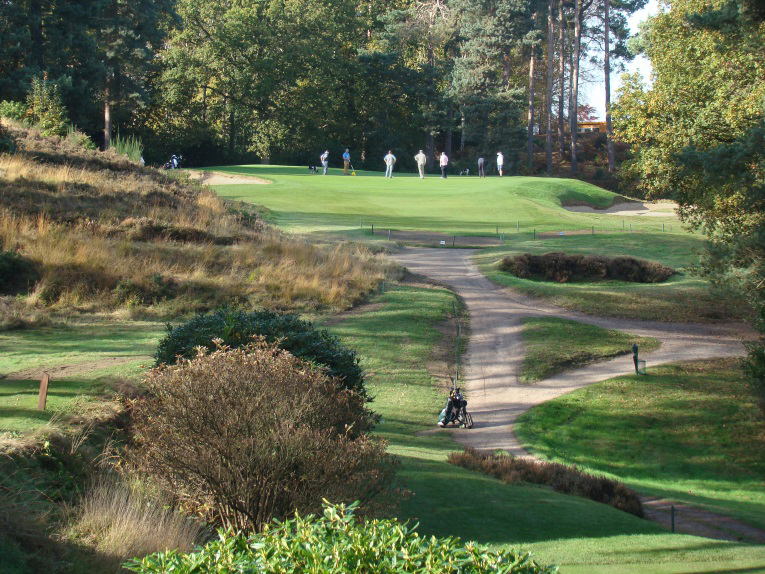
Colt’s manufactured one shotter features both a tee benched into the hillside and a pushed-up green pad. Such earthwork wasn’t done pre-1900. Park’s green was snuggled into the valley below and played from to a tee well right, back and much lower.
Tenth hole, 475/460 yards; Grandness is elusive; holes either have it or they don’t. It can’t be faked. London’s heath-belt is littered with good, charming designs of the sort sorely needed in the United States. Such ~6,300 yard courses are human in scale and delightful to walk (often in less than three hours). Sunningdale possesses these same qualities but they are amped up a notch. Here, like the fifth, the golfer enjoys one of the game’s most grandiose tee shots. The sight of one’s tee ball bounding down the green fairway between the heather never ceases to delight. The author can’t recall two such abrupt drops without hill-climbing to follow. Park’s (and to a lesser degree Colt’s) neat routing ploy avoids such an unwelcome ascent.

Patric Dickinson quipped in A Round of Golf Courses, ‘If the tee shot from the fifth is Alpine, this 10th is Himalayan, almost vertiginous.’
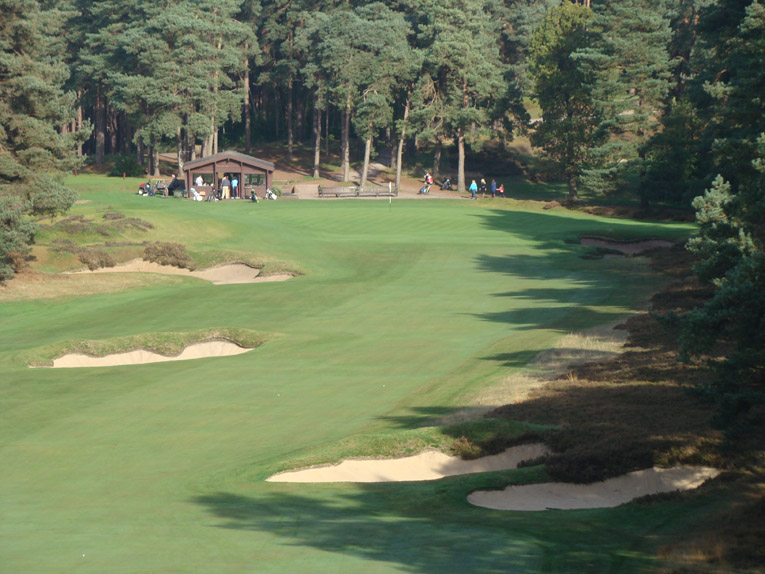
Sunningdale’s halfway house greets the golfer after completion of the tenth. Perhaps a sausage roll or ‘…other things’ (as Darwin noted with a smile) are in order? Put another way, people without an aversion to alcohol are also welcome.
Eleventh hole, 320/300 yards; Discomfort is a desirable quality for a short two shotter. Without it, the hole is likely of little consequence; it’s better that the player be pestered by one or another feature. An unsettling blind tee ball over a bank of heather is the first conundrum, followed by a wall of pine trees that extend from the right side of the green for some fifty-five yards. The slightest push or fade immediately transforms the golfer from hunter to prey. Finally, the raised green, at 4,700 square foot the smallest target on the course, completes the discountenance. Brilliantly, the mighty tenth (that plays to the largest green on the course) is juxtaposed to the drivable eleventh, representing sterling variety of the sort that few designs possess.
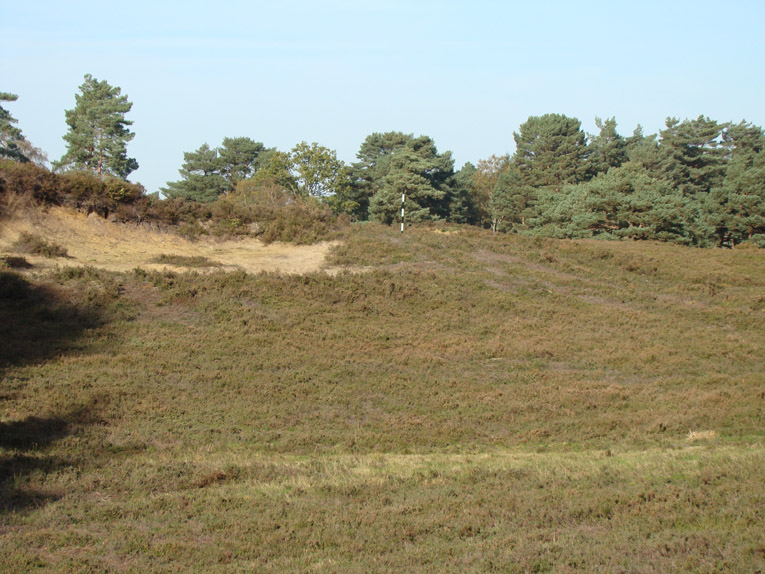
The view from the eleventh tee: Blind and better for it. A lesser club would have consulted with a lesser architect and bulldozed the ridge.
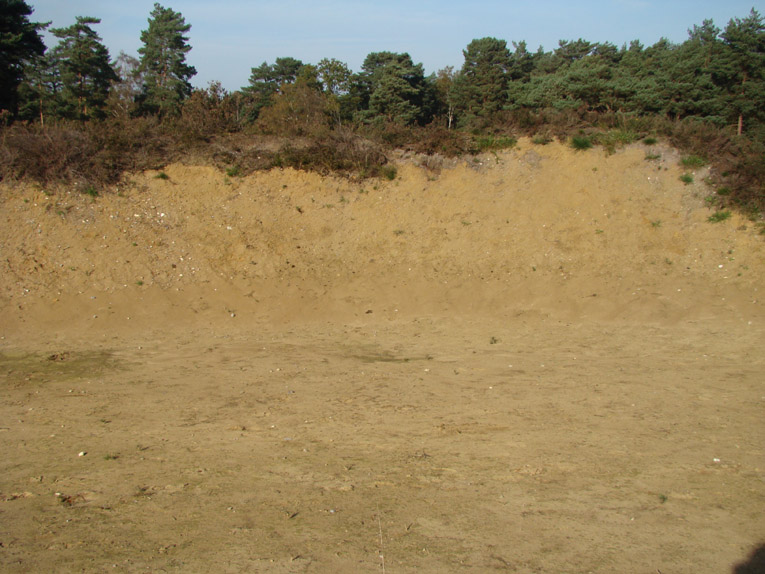
Replete with shells, the sand quality is such that one might think that the North Sea lies just ahead. Sheridan, a Scot from North Berwick noted, ‘Another thing I found most strange was the great number of people playing golf in the winter months.’ Play year round is another benefit afforded heathland courses.

Should the golfer prematurely come out of his tee shot to peek at his tee ball, his weak fade will result in this discouraging view of the flag shrouded by boughs of pine.
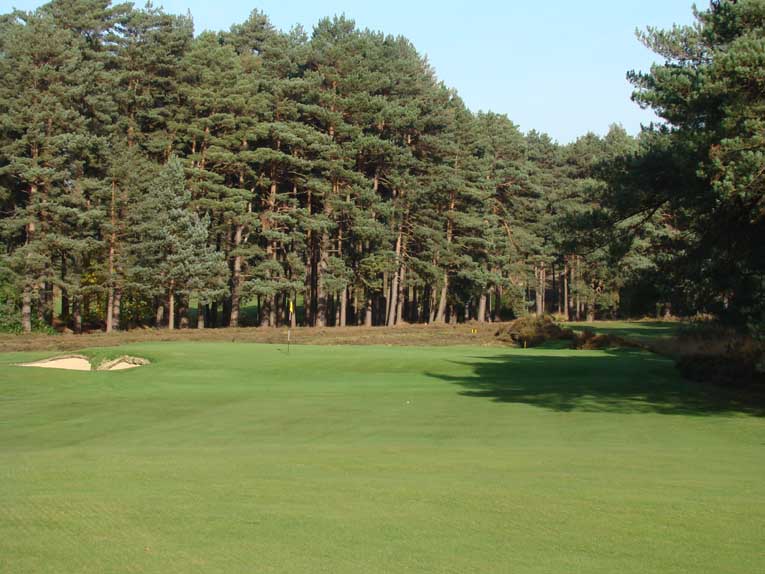
Does the player capable of hitting such a mighty tee ball also possess the finesse and delicacy required to get this little pitch close?

The margin of error greenside is small. The eleventh green once wrapped around this bunker and protruded left but technology rendered such hole locations defenseless so the left portion of the green was removed over sixty years ago.
Twelfth hole, 440/415 yards; For a course to be considered word class – among the top 25 or so – it must possess world class golf holes. It’s indisputable that this is one such hole. This is one of Colt’s post 1910 alterations and a masterstroke. By moving Park’s green some seventy yards up and to the left, Colt created a hole that is as searching as it is handsome. Anyone can build a difficult hole, but a hard hole that inspires affection is something wonderful.
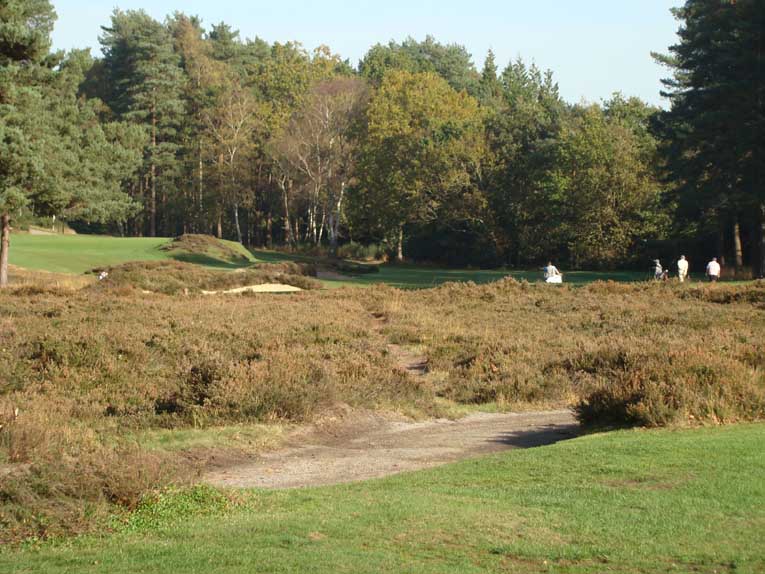
Not revealed from the tee is the manner in which the fairway elbows left. There are different ways to use heather and creating uncertainty is one of them.

Dickinson opined ‘…the thing about Sunningdale is that it seems such ‘natural’ golf. For an inland course this is a rare quality.’

Colt’s large plateau green required substantial earth-moving but it’s tied perfectly to the hillside.
Thirteenth hole, 185/175 yards; This is the most user-friendly of the one shotters and it’s an ample target with everything graciously laid before the golfer. Absent is the steeply pitched fourth green, the sharp fall-off at the eighth or the fifteenth’s bruising distance. What does all that mean? It’s the one green that Jones missed in regulation: Go figure!
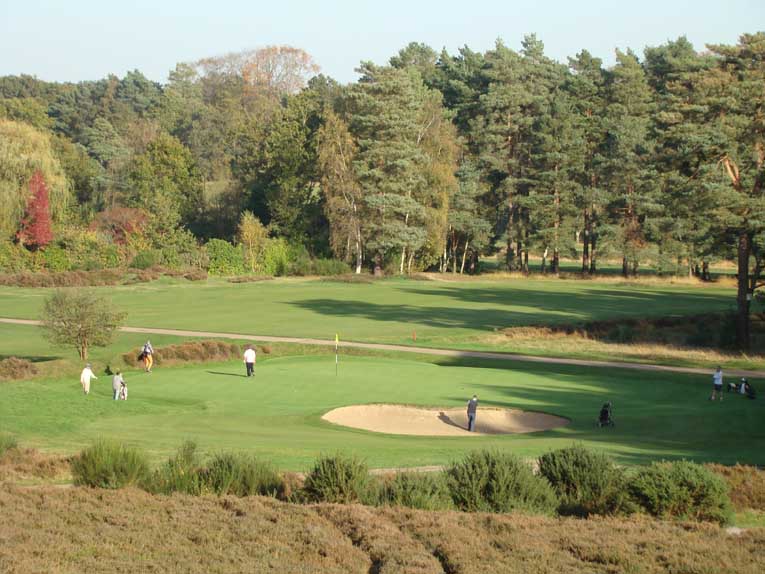
The prospects from Colt’s elevated thirteenth tee are more cheerful than at the other one shotters. Darwin hailed Colt’s modifications: ‘The thirteenth, as I said, was once one of the very worst holes in the world, and is now a thoroughly attractive one.’
Fifteenth hole, 240/220 yards; The master architects of the Golden Age strived for variety among their one shot holes. Almost by definition a wood would be required at one of them. Professionals and amateurs of that era expected such and got on with the task at hand but today’s sniveling professional would gasp if confronted with a 280 yard one shotter requiring a 3 wood. Most of us use that club here and marvel how this flat hole hasn’t been tricked/messed up over the years. The features are at grade and nothing is provided to comfort or aid the golfer’s depth perception. Holes should reflect their environment and that includes flat ones.
Sixteenth hole, 435/425 yards; Park’s hole gently flows across a valley in which the golfer is blissfully surrounded by heather, birch and pine. Like hole 5, this one kicks off a trio of sturdy 400 yard plus challenges. Darwin penned in The Golf Courses of the British Isles, ‘ Of all the inland courses Sunningdale is perhaps the richest in really fine two-shot holes, where a brassey or cleek shot lashed right home on to the green sends a glow of satisfaction through the golfer’s frame.’ That’s certainly true but an equal case can be made that in this day and age, Sunningdale is first and foremost a superlative test of driving the ball. Good driving is paramount because bunker schemes and bands of heather conspire to force the errant driver to lay well back (e.g. the 5th, 6th, 7th, 10th, 12th, here, 17th and 18th). Though most tees demand a certain amount of carry to reach the fairways, the green complexes tend to allow for approaches played along the ground.

Seven horseshoe bunkers extend well out from the elevated green. If the golfer doesn’t place his tee ball in the fairway, getting past them in two is problematic.
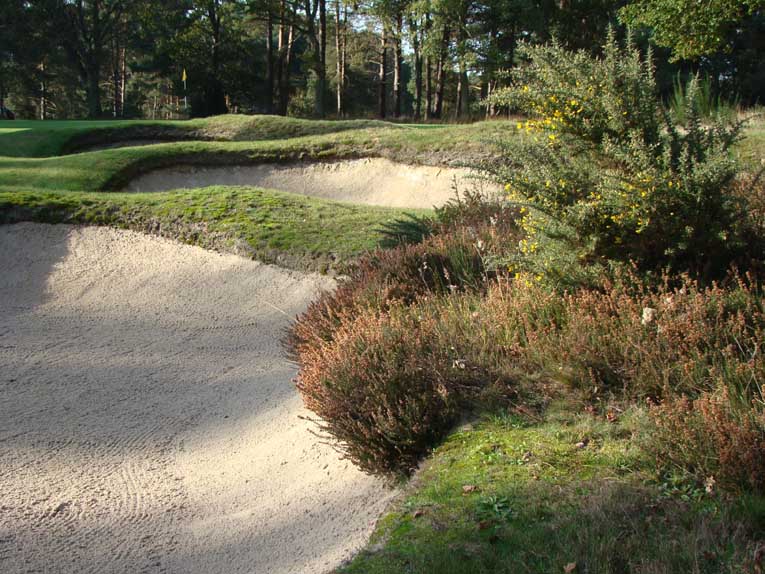
Golden Age architects viewed upslopes as ideal canvases for bunkers with character – so it is at the sixteenth!
Seventeenth hole, 425/415 yards; Home holes bring the golfer back to the clubhouse and professional shop. Sunningdale’s finish is unique in that the valley that falls away from the clubhouse was broad enough for not one but two holes. The huge oak tree and the Sunningdale clubhouse are iconic in the golf world and the golfer admirers them at both the penultimate and Home holes. Be it the lighthouse at Harbour Town or Riviera’s clubhouse, most landmarks are appreciated only at the last. As for the golf, the fairway bends right but the ground in the landing area slopes left. The old trooper delights in needing to shape his tee ball to hit and hold the optimal spot in the fairway.
Eighteenth hole, 425/410 yards; For a course with such severe topography it is remarkable that the Home hole is the only hole where both the drive and approach are guaranteed to play markedly uphill. As such, it plays longer than advertised and makes for a satisfying, if testy, conclusion. A diagonal string of four bunkers occupy an area 40 to 80 yards short of the green and come screaming into play should the golfer not get away a good drive. Here is Guy Bennett’s account of the hole’s evolution in The Sunningdale Story:
Like the seventeenth, the eighteenth green was re-sited nearer the big oak tree in order to make room for the New Course. It was larger than at present with a very wide entrance so that any sort of second shot, given sufficient length, could find it. In the autumn of 1940, a squadron of German planes dropped upwards of ninety high explosive and incendiary bombs in and around Sunningdale. One of the former made a large crater on the right hand near side of the green. Whilst clearing up the mess, someone had the bright idea of making two insidious bunkers on the site of the bomb hole, thus transforming the second shot from very ordinary to first class. It is amazing how many balls they catch. The writer on one occasion counted nine consecutive professionals playing their seconds into or to the right of these bunkers. The large bunker to the left of the drive, once called “John’s” bunker, after its designer John Morrison, was so placed to check those who endeavored to drive too much onto the first fairway.

This view across the seventeenth green and up the eighteenth hole shows the fairway bunkers en echelon prior to the Home green.
There you have it – a wondrous walk with nature, made all the better by some of the best minds that the game has known. One last quality to make note of: the Old’s mesmerizing pacing. Easier holes are spliced with the hardest and enable the golfer to be hopeful through his round. Too many modern courses feature holes that are hard and harder, that punish and ultimately demoralize the player. Players can age gracefully here with their dignity in tact. Sunningdale is the rare place where one’s love of the game actually flourishes – instead of diminishing – with each visit. No wonder the man who played the ‘perfect round’ remarked, ‘It’s a wonderful course, Sunningdale and I wish I could carry it about with me. I wanted to bring it back home…’
We can not play like the maestro but we share his sentiment.


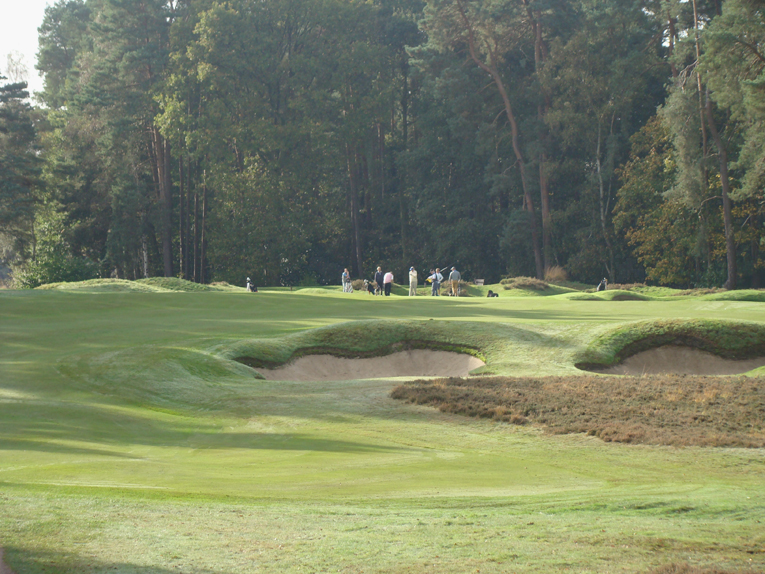

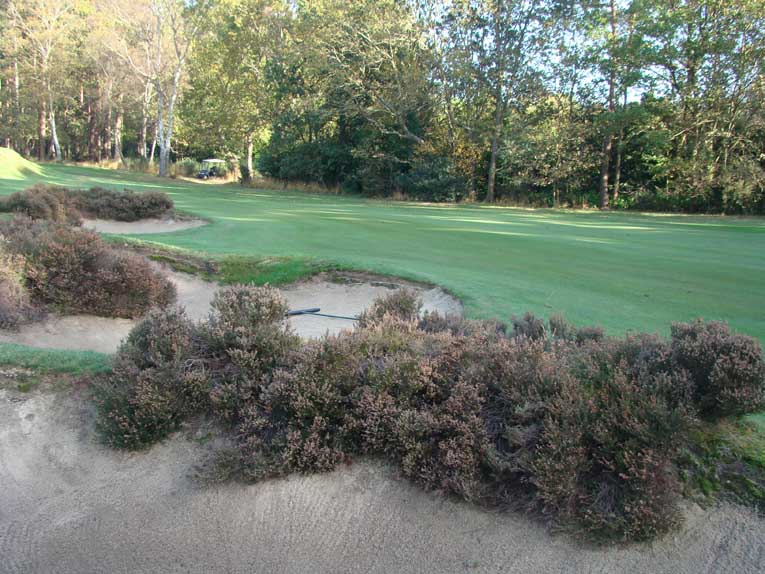
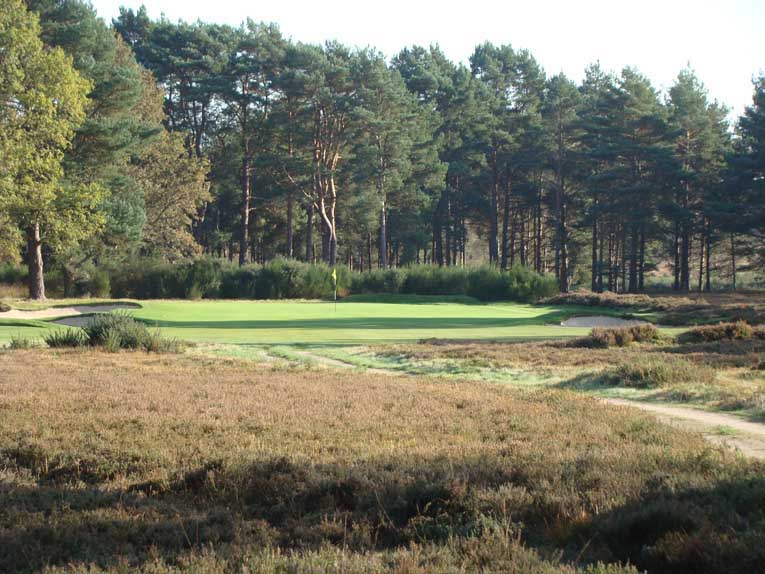
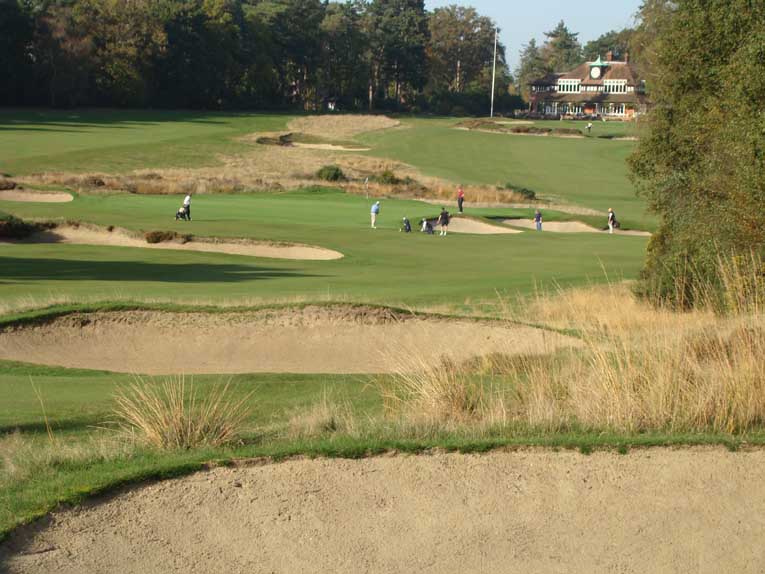


![Minchinhampton (Old) [2016]](https://golfclubatlas.com/wp-content/uploads/2018/09/Minchinhampton-500x383.jpg)
![St. Enodoc (Church) [2017]](https://golfclubatlas.com/wp-content/uploads/2017/11/St.-Enodoc-500x383.jpg)
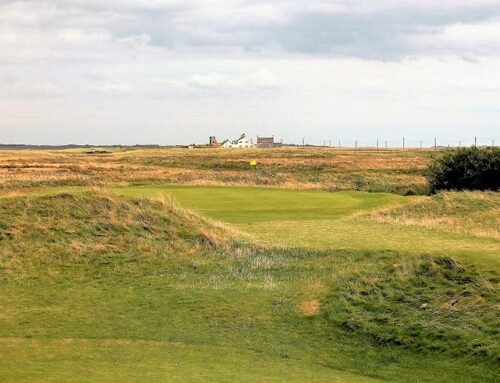
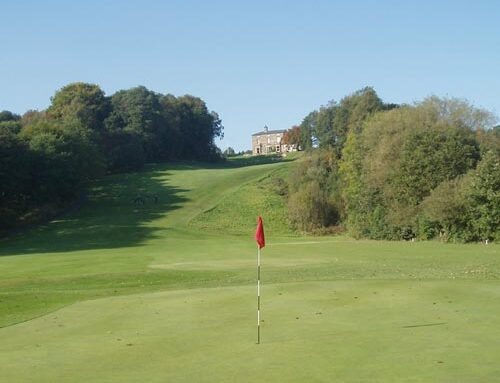
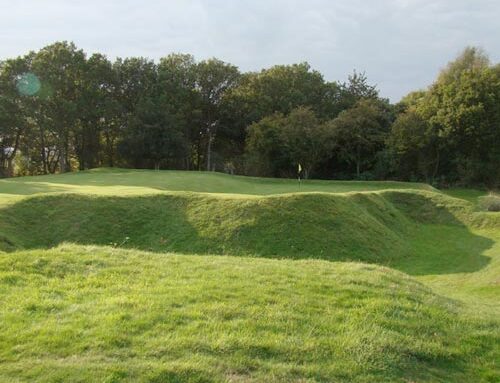
![Sunningdale (New) [2009]](https://golfclubatlas.com/wp-content/uploads/2010/12/Sunningdale-New-Course-500x383.jpg)